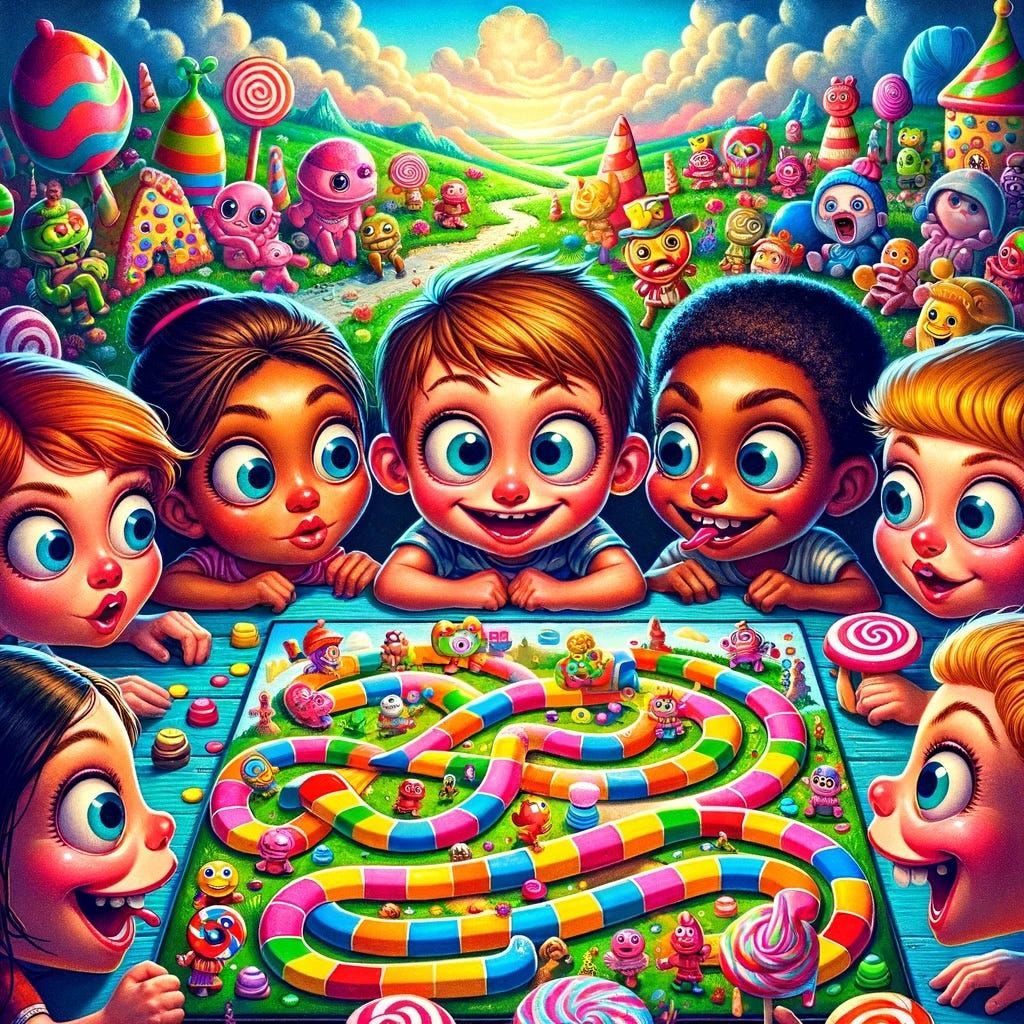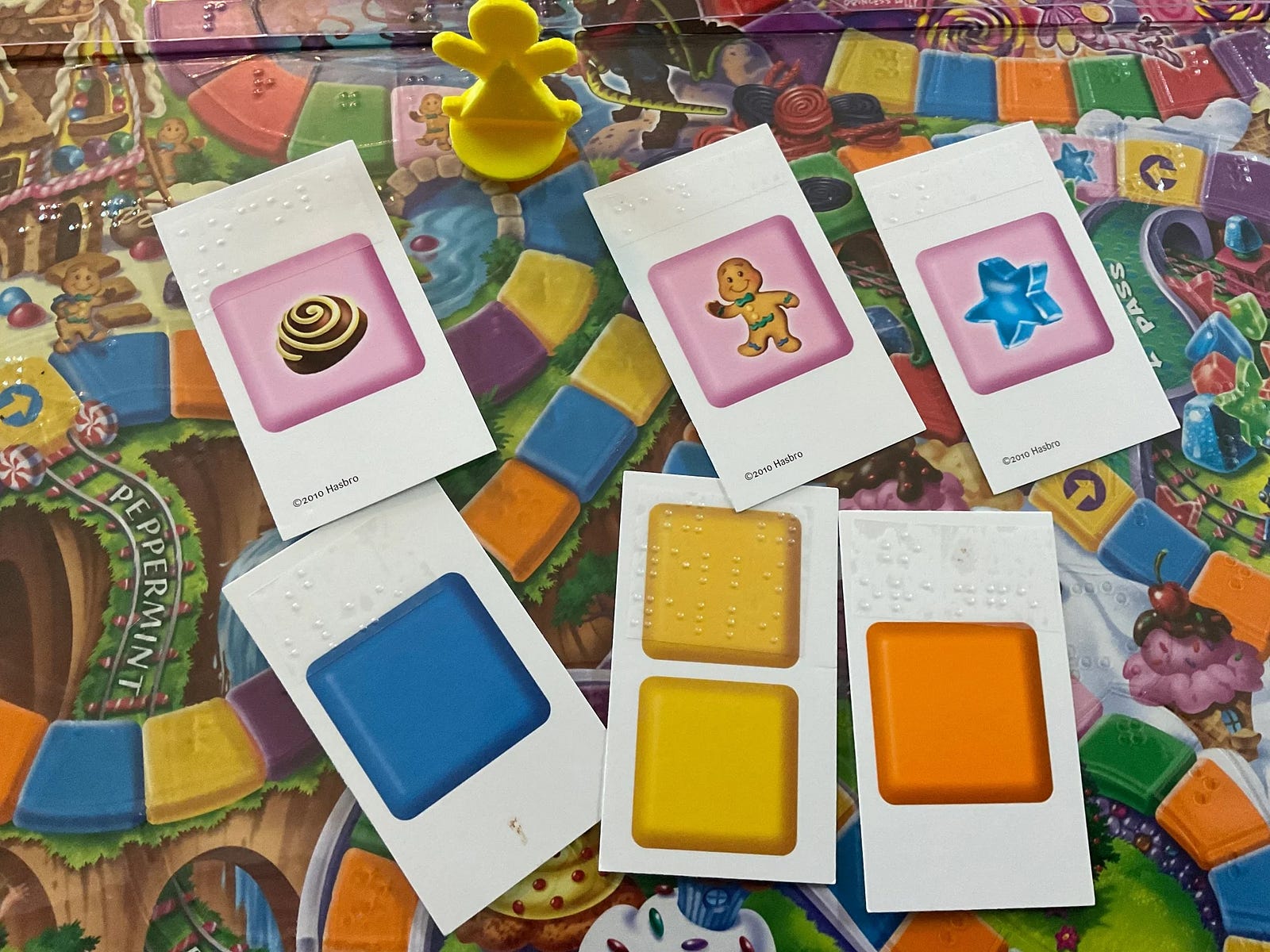Candy Land: Will This Game Ever End?
Is it possible to for a game of Candy Land to go on literally forever? The author f’s around and finds out.

Is it possible to for a game of Candy Land to go on literally forever? The author f’s around and finds out.
“No, please”, I begged her, “don’t do it”.
My wife looked up from her phone and locked eyes with mine. Slowly, she raised the phone and turned it so I could bear witness. She lifted her other hand to the phone and–with a wry smile–tapped “Purchase”.
Candy Land. With that simple tap, my wife had purchased Candy Land for our darling 5-year-old for Christmas. And in doing so, doomed us to hours of insufferable gameplay.
If you’ve played the kids’ game Candy Land, you know that it feels like it goes on forever. But can it actually, literally go on forever? In this post, I set off to find out.
The First Rule of Candy Club
If you are unfamiliar with Candy Land, congratulations! But sadly, I’ll need to explain the rules to you so you can understand the rest of this post.
Candy Land is a kids’ boardgame in which players attempt to navigate over a series of colored squares through a land made out of candy. A “CANDY-LAND” if you will. The goal is to reach the Candy Castle, but various obstacles along the way make the task more difficult.
What’s great (I guess) about Candy Land is that it’s a board game that even the smallest kids can play. With a bit of assistance, even 3-year-olds can participate in game night. Sure, I can appreciate that.

So why is Candy Land such an aggravating game then? Well, for one thing, there is no strategy at all. There are, in fact, no decisions made by the players. Each turn, a player picks up the next card from the deck which tells them how far to advance. Occasionally, a special card will send the player to another square far away on the board–sometimes forward, sometimes back.
So without any player influence on how each turn unfolds, you have no control whatsoever over the outcome. You are just a passive vessel for the game of Candy Land. In mathematical terms, the game is fully deterministic. The outcome was decided before you even started, you just don’t know it yet.
You have no control whatsoever over the outcome. You are just a passive vessel for the game of Candy Land.
The fact that the game is deterministic is aggravating enough, but what makes it worse is that the game–seemingly–goes on forever. Because the special cards can send you back in the board and erase most of your progress, the game can drag on seemingly indefinitely.
Most of our games with our son eventually do end, after far too long. And sometimes we have to simply stop playing when the game has outlived its welcome (though the 5 year old disagrees). But during a particularly painful game, I asked the question: is it possible for a Candy Land game to actually go on forever?
Constructing an Imperfect Game
To figure out if a never ending-game is actually possible, we started to analyze the game:
- there are 64 cards, or 66 depending on who you ask (the official rules state 64, while people with the actual gamecount 66)
- each card determines how the player moves: either a single color (move to the next square of that color), a double color (move forward two squares of that color), or a special candy image (move to the special square)
- there are 134 spaces from the start of the game to the Candy Castle
- after a card is are used, is it placed back at the bottom of the deck
With these rules in mind, we can describe how a never-ending sequence would work. A never-ending game sequence for a single player would be a sequence of cards that form a loop of destinations: if a player ends up on the same square at the same point in the card sequence, we have defined a loop.
So to get a never-ending two player game, we simply need to find two distinct loops of 33 cards and interleave them.
With this realization in mind, our Infinite Candy Land seemed so close I could, uh, taste it. “I know!”, I announced proudly, “I’ll write a Candy Land simulation and use some search techniques to find overlapping Candy Land loops. Maybe a genetic algorithm or Monte Carlo simulation would be a good app-…” I trailed off as I opened my laptop.
My wife rolled her eyes and pushed the laptop closed. “It’s simple”, she said.

Don’t Overthink It
So it turns out, no fancy search techniques are needed. It’s trivial to create a never ending game. Once we figured out how, we were able to do so on our first attempt.
Here’s how we did it. The following is a description of the loop for a single player, so is done with 33 cards–4 “special” cards and 29 regular color cards:
- The first card in the loop is a “special” card near the start of the board–it brings the player to the specified square on the first turn.
- The other “special cards” are distributed evenly throughout the deck so that when a player starts to approach the goal, they are pulled back to elsewhere on the board.
- After playing the 33rd card, the sequence starts again and the player starts again on the initial “special” square on their 34th turn.
It turns out constructing a deck following these rules is simple. And if we do the same thing for the other subset of 33 cards, we can have a sequence for the other player. If we then interleave these two sequences, voila the game of Candy Land will in fact go on forever.
Game Over
So, as it turns out, the game doesn’t just feel like it goes on forever. It can literally go on forever. In fact, some readers of this may be caught in an endless loop of Candy Land at this very moment. Condolences.
Of course, this all makes the assumption that you don’t make the common sense modification of shuffling the cards when they run out. But hey, rules is rules. Also, I’m informed that some newer editions of Candy Land actually come with a spinner instead of cards. But for the sake of this rant, I am a strict Candy Land Originalist.
Jonathan is a master-level Candy Land player. When he’s not playing candy land, he can be found running or scouring the internet for running shoes.
